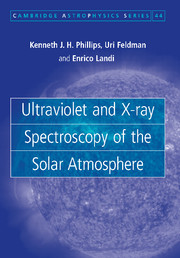Book contents
- Frontmatter
- Contents
- Preface
- 1 The solar atmosphere
- 2 Fundamentals of solar radiation
- 3 Fundamentals of atomic physics
- 4 Mechanisms of formation of the solar spectrum
- 5 Plasma diagnostic techniques
- 6 Ultraviolet and X-ray emission lines
- 7 Spectrometers and imagers for observing the solar ultraviolet and X-ray spectrum
- 8 Quiet Sun and coronal holes
- 9 Active regions
- 10 Solar flares
- 11 Element abundances
- Appendix 1 Units
- Appendix 2 Line lists
- Glossary
- Further reading
- References
- Index
5 - Plasma diagnostic techniques
Published online by Cambridge University Press: 07 December 2009
- Frontmatter
- Contents
- Preface
- 1 The solar atmosphere
- 2 Fundamentals of solar radiation
- 3 Fundamentals of atomic physics
- 4 Mechanisms of formation of the solar spectrum
- 5 Plasma diagnostic techniques
- 6 Ultraviolet and X-ray emission lines
- 7 Spectrometers and imagers for observing the solar ultraviolet and X-ray spectrum
- 8 Quiet Sun and coronal holes
- 9 Active regions
- 10 Solar flares
- 11 Element abundances
- Appendix 1 Units
- Appendix 2 Line lists
- Glossary
- Further reading
- References
- Index
Summary
Introduction
In this chapter we will review the main diagnostic techniques that allow the measurement of the physical properties of optically thin plasmas. These techniques can be used to measure the electron and ion temperatures, electron density, the thermal structure of the plasma, its chemical composition and ionization state, its dynamics, and the velocity distribution of its electrons. Most, but not all, of the techniques we describe assume that the emitting plasma is (i) thermal; (ii) homogeneous and isothermal; and (iii) in collisional ionization equilibrium. The effects of the relaxation of one or more of these assumptions will be discussed when possible, although the effects of departures from ionization equilibrium are difficult to study because of the complexity of evaluating ion abundances in the dynamic environment of out-of-equilibrium plasmas.
Diagnostic techniques require atomic databases and spectral codes to be used. These codes are necessary to provide theoretical estimates of line and continuum fluxes as a function of the physical parameters of the plasma, whose comparison with observations provides the measurement of such parameters. In this chapter, we also briefly review the main spectral codes available in the literature. The diagnostic techniques we discuss can be used with either fluxes (radiances) or intensities (irradiances), but for clarity we will mostly use fluxes.
Electron density diagnostics
Line flux ratios
Measuring electron densities using the flux ratio of two spectral lines is the most popular method.
- Type
- Chapter
- Information
- Ultraviolet and X-ray Spectroscopy of the Solar Atmosphere , pp. 119 - 163Publisher: Cambridge University PressPrint publication year: 2008

